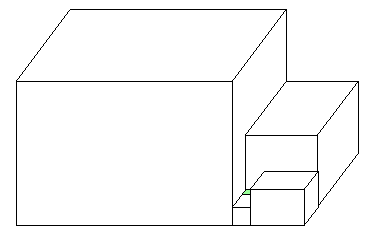
The Mathematical Study of Mollusk Shells
4. Things get complicated in three dimensions,
The Molluskville model owed some of its simplicity to being
in Flatland; when the same kind of zoning laws are extended
to 3-dimensional dwellings the implementation must be more
complicated, because the height of the dwelling must be
scaled up along with its width and length. This forces each
dwelling to approximate an infinite sequence of joined
chambers. In that way, when an extra room is added on, the
renovation can be similar to the original house.

The model house has an infinite sequence of
ever-smaller rooms.


A typical house (the suite of smaller rooms is represented by
a single green chamber) and its first three renovations.
but Calculus comes to the Rescue
Since mollusks add onto their shells in small increments (rather
than the large rooms in the illusration above) we may approximate
the discrete and small by the continuous and the infinitesimal and
apply Calculus to determining the mathematical consequence of
terminal growth and unchanging form.
- We start by supposing that the shell is growing steadily and smoothly as
a function of a parameter t, which is a monotonic function
of time. If we take a reference point
on the growing edge of the shell, it will describe a curve F(t)
in 3-space as the organism grows.
- Since the shell grows by accretion, the shell at any time T
will bear the entire image of the curve up to then. At a later time
T+h the image will be the curve F(t+h) for the
same t-values.
The "unchanging form "
requirement means in particular that the new curve must be geometrically
similar to the old. Since the seed point, or center, of the shell
stays fixed,
there must be
a 3-dimensional rotation Rh and a dilation Dh
which together take the first curve to the second:
F(t+h) = Rh Dh F(t).
- Unless F(t)is a straight line, the similarity transformations
Rh and Dh are uniquely determined
by h and vary smoothly with h.
If we compare F(t) with F(t+h1),
F(t+h2), and F(t+h1+h2),
we see that the dilation
D(h1 + h2)
must be the composition of the dilations Dh1
and Dh2:
first you do Dh1,
then you do Dh2. To dilate a figure
you multiply all its dimensions by a "dilation factor." The dilation
factor of h1 + h2 must therefore be the
product of the the dilation factors of h1
and h2. Since h=0 must correspond to
dilation factor 1, the only possibility is for there to
exist a constant v such that Dh is equal
to dilation by a factor evh.
- Similarly the rotation corresponding to
h1 + h2
must be the composition of the two rotations
Rh1 and Rh2,
for any h1 and h2.
The Rh therefore form
what is called a 1-parameter group of rotations, and there is only one
way
this can happen: there is a constant c, and a set (x,y,z) of
coordinates in 3-space so that, for every
h, Rh is the rotation about the z-axis
by an angle ch:
Rh(x,y,z) = (x cos(ch) - y sin(ch),
x sin(ch) + y cos(ch), z).
See For further thought for some
more details of this calculation.
- Applying the equation
F(t+h) = Rh Dh F(t) to h=t
and t=0 yields F(t) = Rt Dt F(0),
so if
F(0) = (x,y,z), in coordinates chosen as above,
then the curve
F(t) traced out on the shell must be
F(t) = evt(x cos(ct) - y sin(ct), x sin(ct) + y cos(ct), z).
This calculation shows how the conditions of terminal growth
and unchanging form imply that any reference point on the shell
must, during growth, trace out a 3-dimensional equiangular spiral.
This matches the D'Arcy Thompson
quote at
the beginning of this article.
It should be
noted that when c=0 the equiangular spiral degerates
to the straight line F(t) = evt(x,y,z). The corresponding
shells, organized as pure cones, do exist, for example in Foraminifers of
the genus Dorothia and in the fossil ammonite
Didymoceras on exhibit at the American Museum
of Natural History.
@ Copyright 2001, American Mathematical Society.




